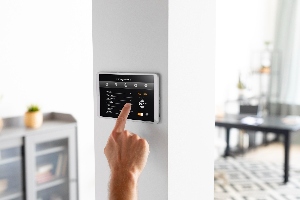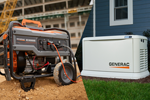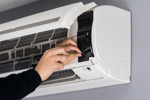While waiting for professional help, there are steps you can take to manage HVAC emergencies safely and potentially prevent further damage to your system. Safety should always be your priority when dealing with HVAC emergencies. The first step is to turn off your system at the thermostat and the main electrical panel if you notice unusual sounds, smells, or complete system failure.
Documenting the issue with notes or photos can also help the technician diagnose the problem faster when they arrive. If you notice any water leakage, shut off the water supply to the unit to prevent potential water damage to your home while waiting for professional assistance.
Recognizing HVAC Emergencies
Knowing when an HVAC problem requires immediate attention can save you from discomfort, costly repairs, and potential safety hazards. Not every issue needs an emergency call, but some situations demand quick action.
Identifying Common Issues
Strange noises like grinding, screeching, or banging from your HVAC system often signal mechanical problems that need attention. These sounds usually indicate loose parts, worn out or failing. Unusual smells deserve immediate attention, too. A burning odor might indicate electrical problems, while musty smells suggest mold growth.
Water pooling around your unit is another warning sign. This typically happens because of a clogged drain line and can lead to water damage if not addressed quickly. System failure, when your heating or cooling stops working entirely, is an obvious emergency, especially during extreme weather conditions.
Other warning signs that require immediate action:
- Electrical sparking or smoke
- Gas odors (rotten egg smell)
- Excessive condensation or leaking
- Frozen coils in summer
- Complete loss of heating in winter
Assessing the Urgency
Temperature extremes play a major role in determining urgency. A broken AC during a mild spring day is less critical than during a heatwave, where it can become a health concern, especially for vulnerable household members.
Issues that affect safety are true emergencies, these include gas leaks, electrical problems, or burning smells that require immediate shutdown of the system and professional help. The age and maintenance history of your system also needs to be considered. Well-maintained systems rarely experience catastrophic failures, while neglected ones are more prone to serious breakdowns.
Immediate Response Tactics
When an HVAC emergency strikes, taking swift action before professional help arrives can prevent further damage and keep your home comfortable. These immediate steps can buy you valuable time while waiting for a technician.
Power System Assessment
First, check if the issue stems from an electrical problem by locating your circuit breaker panel and looking for any tripped breakers related to your HVAC system. Reset any tripped breakers by flipping them fully off, then back on. Then, inspect your thermostat to ensure it has power and is set correctly. Replace batteries if needed. Sometimes, a simple power cycle can resolve electronic control issues.
Verify that all power switches for your system are in the "on" position. Many HVAC units have disconnect switches located near the outdoor unit or at the furnace that might accidentally get turned off. If you smell gas or burning, immediately shut off power to the system at the circuit breaker and contact emergency services.
Temporary Temperature Containment
Close blinds and curtains on sun-facing windows during cooling emergencies to block heat. In winter emergencies, open them during sunny hours to capture natural warmth. Seal unused rooms by closing doors and vents to concentrate heating or cooling in essential living areas. You can also use rolled towels or door draft stoppers to prevent air leakage under doors.
Set up portable fans to circulate air during cooling emergencies. In cold situations, consider safe space heaters for critical areas, keeping them away from flammable materials. Layer clothing and use blankets during heating failures instead of risky heating alternatives. For cooling issues, stay hydrated and use cool, damp cloths on pulse points.
Safety Precautions and Measures
When facing an HVAC emergency, taking proper safety measures protects you and your property while preventing the situation from worsening.
Power Shutdown Procedure
Locate your electrical panel and switch off the power to the HVAC system. The breaker should be clearly labeled as "HVAC," "Furnace," or "Air Conditioner." If you're unsure which breaker controls your system, turn off the main power switch as a precaution. Always use dry hands, stand on a dry surface when handling electrical panels, and never touch wires or attempt to fix electrical components yourself.
For gas-powered systems, take note of where the gas shutoff valve is located. It's typically near the furnace or on the gas line leading to it. Turn the valve perpendicular to the pipe to stop gas flow if you detect a gas odor. It’s helpful to document the time you shut down the system and to provide this information to technicians when they arrive.
Preventing Further Damage
Clear the area around your HVAC equipment of any flammable materials, including paper, cleaning products, and fabric. Maintain at least a three-foot clearance around all units. If water is involved, use towels or buckets to collect leaking water and prevent it from spreading to walls or flooring. Avoid stepping in standing water, especially near electrical equipment.
If safe to do so, take photos of visible damage for insurance purposes and to help technicians understand the situation before they arrive. However, for refrigerant leaks, ventilate the area immediately by opening windows and doors. Do not remain in spaces with suspected refrigerant leaks, as they can cause respiratory issues.
Preparation for Technician Arrival
When your HVAC professional arrives, having everything ready will help them diagnose and fix your problem faster. Proper preparation can reduce repair time and potentially lower your bill.
Documenting the Incident
Take clear notes about what happened with your HVAC system, writing down when you first noticed the problem and any unusual sounds, smells, or behaviors from the unit. Also, record any error codes displayed on your thermostat or system controls, as these codes often provide technicians with specific diagnostic information.
Take photos or videos of visible issues like water leaks, frost buildup, or damaged components. This visual evidence can be especially helpful if the problem is intermittent. Additionally, make a list of any troubleshooting steps you've already attempted. Note whether these actions made any difference, even temporarily.
Clearing Access to HVAC Systems
Technicians need at least 2-3 feet of clear workspace around your equipment, so remove all items stored around indoor and outdoor HVAC components. Ensure electrical panels are accessible, too.
Move vehicles from the driveway if they block access to outdoor units and ensure gates are unlocked if the technician needs to access your backyard. In winter, clear snow and ice from outdoor units and the paths leading to them, and in the summer, trim back any vegetation growing too close to the equipment. Secure pets in a separate room to prevent them from interfering with the repair work.
Get in touch to arrange emergency repairs to prevent further damage to your HVAC system.













